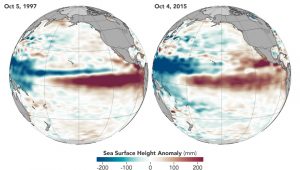
A comparison of the 2014-2016 and 1997-1998 El Niños, two of the strongest on record, in October of each respective year.
Credit: NASA’s Earth Observatory.
El Niño and La Niña are the warm and cool phases of a recurring climate pattern across the tropical Pacific Ocean called the El Niño-Southern Oscillation, or ENSO. The warm and cool phases shift back and forth every two to seven years, and each phase triggers predictable disruptions in temperature, wind, and rain across the globe. During El Niño events, water temperatures at the sea surface are higher than normal. Low-level surface winds, which normally blow east to west along the equator, or easterly winds, start blowing the other direction, west to east, or westerly.
Several American Geophysical Union scientists are available to comment on the science of ENSO, including variability, forecasting and effects on climate.
Amy Clement is a professor in the department of atmospheric science at the Rosenstiel School of Marine and Atmospheric Science at the University of Miami in Miami, Florida. She studies the causes of climate change on all timescales, from glacial periods to future climate change. Her research focuses on the coupled atmosphere-ocean system, including ENSO and other climate cycles.
Email: [email protected]
Phone: +1 (305) 421-4846
Mike Jacox is a research oceanographer at the NOAA Southwest Fisheries Science Center in Monterey, California and the NOAA Earth System Research Laboratory in Boulder, Colorado. His expertise is in the connections between climate variability, physical oceanography and marine species responses, particularly off the North American west coast.
Email: [email protected]
Phone: +1 (831) 648-8536
Ben Kirtman is a professor in the department of atmospheric sciences at the Rosenstiel School of Marine and Atmospheric Science at the University of Miami in Miami, Florida. He studies climate variability, predictability and prediction on timescales of days to decades and has published extensively on ENSO prediction and predictability.
Email: [email protected]
Phone: +1 (305) 421-4046
Michelle L’Heureux is a physical scientist at the NOAA Climate Prediction Center in College Park, Maryland. She is the lead of the ENSO team, which is responsible for issuing regular updates on the status and forecast of El Niño and La Niña. She also works with the community on applied research to enhance scientific understanding and prediction of ENSO and other climate phenomena.
To speak with Michelle L’Heuruex, contact Lauren Gaches at NOAA Public Affairs at [email protected] or +1 (301) 683-1327.
Looking for experts in other topic areas? Visit AGU’s Stay Informed page for up-to-date expert lists.